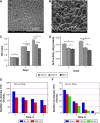Nanomedicine applications in orthopedic medicine: state of the art
- PMID: 26451110
- PMCID: PMC4592034
- DOI: 10.2147/IJN.S73737
Nanomedicine applications in orthopedic medicine: state of the art
Abstract
The technological and clinical need for orthopedic replacement materials has led to significant advances in the field of nanomedicine, which embraces the breadth of nanotechnology from pharmacological agents and surface modification through to regulation and toxicology. A variety of nanostructures with unique chemical, physical, and biological properties have been engineered to improve the functionality and reliability of implantable medical devices. However, mimicking living bone tissue is still a challenge. The scope of this review is to highlight the most recent accomplishments and trends in designing nanomaterials and their applications in orthopedics with an outline on future directions and challenges.
Keywords: implantable materials; nanomedicine; nanotoxicology; orthopedics; tissue engineering.
Figures




Similar articles
-
An overview of nano-polymers for orthopedic applications.Macromol Biosci. 2007 May 10;7(5):635-42. doi: 10.1002/mabi.200600270. Macromol Biosci. 2007. PMID: 17477446 Review.
-
Nanosurfaces and nanostructures for artificial orthopedic implants.Nanomedicine (Lond). 2007 Dec;2(6):861-74. doi: 10.2217/17435889.2.6.861. Nanomedicine (Lond). 2007. PMID: 18095851 Review.
-
Nanomaterials and synergistic low-intensity direct current (LIDC) stimulation technology for orthopedic implantable medical devices.Wiley Interdiscip Rev Nanomed Nanobiotechnol. 2013 May-Jun;5(3):191-204. doi: 10.1002/wnan.1201. Epub 2013 Jan 17. Wiley Interdiscip Rev Nanomed Nanobiotechnol. 2013. PMID: 23335493 Free PMC article. Review.
-
Adaptive Polymeric Assemblies for Applications in Biomimicry and Nanomedicine.Biomacromolecules. 2019 Nov 11;20(11):4053-4064. doi: 10.1021/acs.biomac.9b01341. Epub 2019 Oct 31. Biomacromolecules. 2019. PMID: 31642319 Free PMC article.
-
A nanocage for nanomedicine: polyhedral oligomeric silsesquioxane (POSS).Macromol Rapid Commun. 2011 Jul 15;32(14):1032-46. doi: 10.1002/marc.201100126. Epub 2011 May 19. Macromol Rapid Commun. 2011. PMID: 21598339 Review.
Cited by
-
Possible Synergies of Nanomaterial-Assisted Tissue Regeneration in Plasma Medicine: Mechanisms and Safety Concerns.Nanomaterials (Basel). 2022 Sep 28;12(19):3397. doi: 10.3390/nano12193397. Nanomaterials (Basel). 2022. PMID: 36234523 Free PMC article. Review.
-
Use of Nanocomposites in Bone Regeneration.Cureus. 2022 Nov 10;14(11):e31346. doi: 10.7759/cureus.31346. eCollection 2022 Nov. Cureus. 2022. PMID: 36523660 Free PMC article. Review.
-
Novel Hybrid Composites Based on PVA/SeTiO2 Nanoparticles and Natural Hydroxyapatite for Orthopedic Applications: Correlations between Structural, Morphological and Biocompatibility Properties.Materials (Basel). 2020 May 1;13(9):2077. doi: 10.3390/ma13092077. Materials (Basel). 2020. PMID: 32369898 Free PMC article.
-
Toxicological Considerations, Toxicity Assessment, and Risk Management of Inhaled Nanoparticles.Int J Mol Sci. 2016 Jun 14;17(6):929. doi: 10.3390/ijms17060929. Int J Mol Sci. 2016. PMID: 27314324 Free PMC article. Review.
-
Role of organic and ceramic biomaterials on bone healing and regeneration: An experimental study with significant value in translational tissue engineering and regenerative medicine.Iran J Basic Med Sci. 2020 Nov;23(11):1426-1438. doi: 10.22038/ijbms.2020.46228.10707. Iran J Basic Med Sci. 2020. PMID: 33235700 Free PMC article.
References
-
- Wang M, Thanou M. Targeting nanoparticles to cancer. Pharmacol Res. 2010;62(2):90–99. - PubMed
-
- Liu H, Webster TJ. Nanomedicine for implants: a review of studies and necessary experimental tools. Biomaterials. 2007;28(2):354–369. - PubMed
-
- Li X, Wang L, Fan Y, Feng Q, Cui F-Z, Watari F. Nanostructured scaffolds for bone tissue engineering. J Biomed Mater Res A. 2013;101A(8):2424–2435. - PubMed
-
- McMahon RE, Wang L, Skoracki R, Mathur AB. Development of nanomaterials for bone repair and regeneration. J Biomed Mater Res B Appl Biomater. 2012;101B(2):387–397. - PubMed
-
- Tran N, Webster TJ. Nanotechnology for bone materials. Wiley Interdiscip Rev Nanomed Nanobiotechnol. 2009;1(3):336–351. - PubMed
Publication types
MeSH terms
Substances
LinkOut - more resources
Full Text Sources
Molecular Biology Databases

